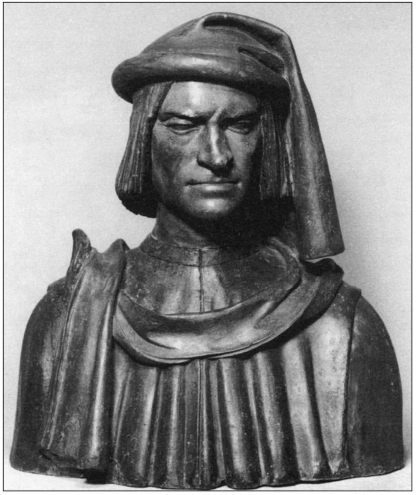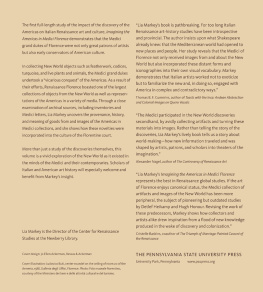PAUL STRATHERN
THE
MEDICI

POWER, MONEY, and AMBITION
in the ITALIAN RENAISSANCE

PEGASUS BOOKS
NEW YORK LONDON
Contents
To Kathleen

Please bookmark your page before following links.
COLOUR PLATES
BLACK AND WHITE ILLUSTRATIONS

| Cosimo Peter Patriae | 14341464 |
| Piero di Cosimo | 14641469 |
| Lorenzo the Magnificent | 14691492 |
| Piero the Younger | 14921494 |
| [Prepublican regime, including Savonarola] | 14941512 |
| Giovanni (later Leo X) | 15121513 |
| Giuliano, Duke of Nemours | 1513 |
| Lorenzo, Duke of Urbino | 15131519 |
| Giulio (later Clement VII) | 15191523 |
| Ippolito and Alessandro under guardianship of Cardinal Passerini | 15231527 |
| [Republican regime, including Republic of Christ] | 15271530 |
| Alessandro | 15311537 |
| Cosimo I | 1537I574 |
| Francesco | 15741587 |
| Ferdinando I | 15871609 |
| Cosimo II | 16091621 |
| Ferdinando II | 16211670 |
| Cosimo III | 16701723 |
| Gian Gastone | 17231737 |
If you take a view of the princes of the Medici in a group, you will feel reverence and respect at one part of the picture and be struck with amazement and horror at the remainder. To revere and know them you must consider their generosity, their benefactions, their policy, and their scientific institutions. To view them with horror and amazement, you need only listen to the undoubted outrages of their private lives.
John Boyle, Earl of Cork and Orrery,
friend of the poet Alexander Pope and
an early British resident of Florence in 1755
I T IS SUNDAY 26 April 1478 in Florence, and the church bells ring out from the towers above the rooftops of the city. Lorenzo the Magnificent, accompanied by his circle of favourites, is making his way through the colourful crowds towards the cathedral of Santa Maria del Fiore.
The twenty-nine-year-old Lorenzo is the head of the Medici family, which along with its allies and powerful political machine controls the affairs of Florence beneath the veneer of republican democracy. Here, amidst the wealth and extravagance of Italys most progressive city, the ancient God-obsessed world of the medieval era is slowly giving way to a new self-confident humanism. The Medici Bank is by now the most successful and respected financial institution in Europe, with offices and agents in all major commercial centres from London to Venice. Even the recent loss of the lucrative papal business to their Florentine rivals, the Pazzi family, is seen only as a minor setback; the profits from the Medici Bank have made Florence one of the architectural and cultural wonders of Europe, enabling the family to commission such artists as Donatello, Botticelli and Leonardo da Vinci. Yet even amongst such geniuses, it is Lorenzo himself who epitomises the new humanism of the Renaissance. Not for nothing is he popularly known as il magnifico; he is the prince of Florence in all but name, and his supporters seek him as godfather to their firstborn male children. Lorenzo sees his rule as a celebration: the people are courted with festivities and carnivals. When commissioning great works of art, his taste is evident; he understands the artists he employs, encouraging them to excel in their own characteristic way and they respect him as an equal in matters of art. He himself is an accomplished musician, athlete and swordsman; he is also well versed in philosophy, and on the way to establishing himself as one of the finest Italian poets of his time; yet for all this, he prides himself on being a man of the people: his apparel is less ornate than that worn by many other Florentine notables. Indeed, apart from the aura pertaining to his implicit power, his appearance is somewhat unprepossessing; the best-known portrait of him a painted terracotta bust by Verrocchio depicts a surprisingly coarse-featured frowning figure: he has the prominent Medici nose and protruding lower jaw, heavy-lidded eyes and wide, but curiously unsensual, narrow-lipped mouth. It is difficult to detect the exceptional man behind such features in repose, though doubtless when enlivened by the power of his personality they exuded that compelling magnetic quality which made him so sexually attractive, and which also attracted the fond admiration of philosophers, artists and even the people.

Fig 1 Lorenzo de Medici
As the bells ring out over the city, Lorenzo and his entourage reach the end of the Via Larga and move towards the cathedral square. Before them, Brunelleschis dome rises against the sky; this dome is perhaps the finest architectural achievement of early Renaissance Europe, outspanned only by the dome of the Pantheon in Rome, which had been built more than a thousand years previously: only now is Europe beginning to catch up with the greatness of its past. Lorenzo and his friends enter the cool, dimmed interior of the cathedral.
Back on the Via Larga, Lorenzos younger brother Giuliano is hurrying to catch up with him, limping from a bout of painful sciatica. He is accompanied by Francesco de Pazzi and his friend Bernardo Bandini, and as they walk down the street Francesco rests a comradely arm around Giulianos shoulder, helping him to overcome his limp, assuring him there is no need to hurry. He gives Giuliano a playful squeeze, noting that he is not wearing any chainmail body-armour beneath his colourful doublet. When they reach the church, Giuliano sees that his brother Lorenzo is already up by the High Altar, surrounded by his friends and two priests, one of whom Giuliano recognises as a tutor to the Pazzi family. The service begins and Giuliano de Medici decides to remain by the door with Francesco de Pazzi, Bernardo Bandini and his companions. The sung responses of the choir ring out in the high, echoing interior of the cathedral beneath the towering dome, then the chanting voices fall silent and the priest conducting the service prepares to celebrate High Mass. The sacristy bell tinkles above the murmuring conversations taking place amongst the informally assembled congregation, and their voices too fall silent as the priest elevates the Host before the High Altar.
The moment the priest raises the Host, two separate incidents take place simultaneously. By the door, Bernardo Bandini whips out a dagger, turns and plunges it into Giuliano de Medicis head with such force that Giulianos skull is split open with a spray of blood. Next, Francesco de Pazzi begins stabbing in a frenzy at Giulianos falling body, slashing again and again, like a man possessed. Such is his mindless fury as he hurls himself forward onto the prostrate body of Giuliano that he is blinded with blood and even plunges his dagger into his own thigh.
Next page














